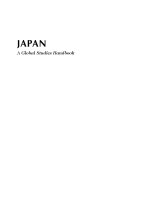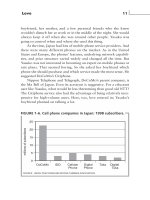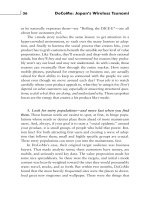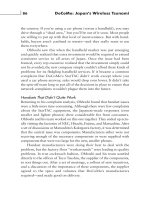japan a global studies handbook
Bạn đang xem bản rút gọn của tài liệu. Xem và tải ngay bản đầy đủ của tài liệu tại đây (1.28 MB, 323 trang )
JAPAN
A Global Studies Handbook
Other Titles in
ABC-CLIO’s
GLOBAL STUDIES: ASIA
Series
The Koreas, Mary E. Connor
FORTHCOMING
China, Robert LaFleur
India, Fritz Blackwell
Nepal and Bangladesh, Nanda R. Shrestha and Bismal K. Paul
Vietnam, L. Shelton Woods
JAPAN
A Global Studies Handbook
Lucien Ellington
GLOBAL STUDIES: ASIA
Santa Barbara, California—•—Denver, Colorado—•—Oxford, England
Copyright 2002 by Lucien Ellington
All rights reserved. No part of this publication may be repro-
duced, stored in a retrieval system, or transmitted, in any form
or by any means, electronic, mechanical, photocopying, record-
ing, or otherwise, except for the inclusion of brief quotations in a
review, without prior permission in writing from the publishers.
Library of Congress Cataloging-in-Publication Data
Ellington, Lucien.
Japan : a global studies handbook / Lucien Ellington.
p. cm. — (Global studies, Asia)
Includes bibliographical references and index.
ISBN 1-57607-271-1 (alk. paper)
1. Japan. I. Title. II. Series.
DS806 .E45 2002
952—dc21 2001007878
06 05 04 03 02—10987654321
This book is also available on the World Wide Web as an e-book.
Visit abc-clio.com for details.
ABC-CLIO, Inc.
130 Cremona Drive, P.O. Box 1911
Santa Barbara, California 93116–1911
This book is printed on acid-free paper.
Manufactured in the United States of America
Contents
Series Editor’s Foreword—ix
Preface—xiii
PART ONE: N
ARRATIVE S
ECTION
—1
1 Japan’s Geography and History—3
The Physical and Human Geographies of Japan—3
The Living Space Problem—11
The Hazards of Being Japanese—15
Japan’s Prehistory—16
Early Mainland Asia and Chinese Influences—18
Classical Japan—25
Medieval Japan—27
Isolation and Peace: Tokugawa Japan—33
Japan Enters the Modern World—38
The Road to War—51
World War II and the Occupation—54
Unparalleled Prosperity and New Challenges—60
2 Japan’s Economy—65
The Roots of Success—65
The Making of the Economic Miracle—69
The End of the Miracle: The Bubble Bursts—82
Japan’s Economic Future—96
3 Japanese Institutions—111
Japanese Government and Politics—112
The Roots of Japanese Democracy—112
v
National Governing Structures:
Theory and Practice—114
Political Parties—119
The Political Problem of the Economic Malaise—122
The Electorate and Government
Reorganization: Solutions?—126
Japan’s Educational System—127
Cultural and Historical
Foundations for Learning—127
The Structure of Japanese Education—129
The Examination Race—136
Student Life and Behavior Patterns—140
Higher Education—141
Educational Reform—143
Japanese Religion—145
Are Most Japanese Religious?—145
The New Religions—154
4 Japanese Society and Contemporary Issues—161
The Group and the Individual in Japan—163
Families and the Role of Women—165
Learning Group Skills: The School—171
The Workplace Group—173
Recreation and Popular Culture—176
Groupism: A Critique—183
Few Babies and Many Old People—191
Japan and the World—196
vi—— Contents
PART TWO: REFERENCE MATERIALS—211
Key Events in Japanese History—213
Significant People, Places, and Events—217
Japanese Language, Food, and Etiquette—233
Written Japanese—233
Spoken Japanese—235
Food—244
Common Japanese Dishes—245
Common Beverages—248
Etiquette—249
Japan-Related Organizations—257
Business and Economic—257
Culture/Education/Exchange—260
Government—268
Tourism—272
Annotated Bibliography—277
Index—287
About the Author—307
——Contents——vii
It is imperative that as many Americans as possible develop a
basic understanding of Asia. In an increasingly intercon-
nected world, the fact that Asia contains almost 60 percent of
all the planet’s population is argument enough for increased
knowledge of the continent on our parts. There are at least
four other reasons, in addition to demography, that it is criti-
cal Americans become more familiar with Asia.
Americans of all ages, creeds, and colors are extensively
involved economically with Asian countries. U.S Pacific two-
way trade surpassed our trade with Europe in the 1970s.
Japan, with the world’s second-largest economy, is also the
second-largest foreign investor in the United States.
American companies constitute the leading foreign inves-
tors in Japan.
The recent Asian economic crisis notwithstanding, since
World War II East Asia has experienced the fastest rate of eco-
nomic growth of all the world’s regions. Recently, the newly
industrialized Southeast Asian countries such as Indonesia,
Malaysia, and Thailand have joined the so-called Four
Tigers—Hong Kong, the Republic of Korea, Singapore, and
Taiwan—as leading areas for economic growth. In the past
decade China has begun to realize its potential to be a world-
influencing economic actor. Many Americans now depend
upon Asians for their economic livelihoods and all of us con-
sume products made in or by Asian companies.
It is impossible to be an informed American citizen with-
out knowledge of Asia, a continent that directly impacts our
national security.
America’s war on terrorism is, as this foreword is com-
posed, being conducted in an Asian country—Afghanistan.
(What many Americans think of as the “Mideast” is, in actu-
——ix
ality, Southwest Asia.) Both India and Pakistan now have
nuclear weapons. The eventual reunification of the Korean
Peninsula is fraught with the possibility of great promise or
equally great peril. The question of U.S China relations is
considered one of the world’s major global geopolitical issues.
Americans everywhere are affected by Asian political and mil-
itary developments.
Asia and Asians have also become an important part of
American culture.
Asian restaurants dot the American urban landscape. Bud-
dhism is rapidly growing in the United States. Asian movies
are becoming increasingly popular in the United States.
Asian-Americans, while still a small percentage of the overall
U.S. population, are one of the fastest-growing ethnic groups
in the United States. Many Asian-Americans exert consider-
able economic and political influence in this country. Asian
sports, pop music, and cinema stars are becoming household
names in America. Even Chinese language characters are
becoming visible in the United States on everything from
baseball caps to t-shirts to license plates. Followers of the
ongoing debate on American educational reform will con-
stantly encounter references to Asian student achievement.
Americans should also better understand Asia for its own
sake. Anyone who is considered an educated person needs a
basic understanding of Asia. The continent has a long, com-
plex, and rich history. Asia is the birthplace of all the world’s
major religions including Christianity and Judaism.
Asian civilizations are some of the world’s oldest. Asian arts
and literature rank as some of humankind’s most impressive
achievements.
Our objectives in developing the Global Studies: Asia series
are to assist a wide variety of citizens to both gain a basic
understanding of Asian countries and to enable readers to be
better positioned for more in-depth work. We envision the
series being appropriate for libraries, educators, high school,
introductory college and university students, businesspeople,
x—— Series Editor’s Foreword
would-be tourists and anyone who is curious about an Asian
country or countries. Although there is some variation in the
handbooks—the diversity of the countries requires slight vari-
ations in treatment—each volume includes narrative chap-
ters on history and geography, economics, institutions, and
society and contemporary issues. Readers should obtain a
sound general understanding of the particular Asian country
about which they read.
Each handbook also contains an extensive reference sec-
tion. Since our guess is that many of the readers of this series
will actually be traveling to Asia or interacting with Asians in
this country, introductions to language, food, and etiquette
are included. The reference section of each handbook also
contains extensive information—including Web sites when
relevant—about business and economic, cultural, educa-
tional, exchange, government, and tourist organizations. The
reference sections also include capsule descriptions of famous
people, places, and events and a comprehensive annotated
bibliography for further study.
—Lucien Ellington
Series Editor
—— Series Editor’s Foreword——xi
It is my hope that Japan: A Global Studies Handbook will be
an informative and useful introduction for American readers
to one of the world’s most important countries. Americans
seem to have more problems understanding Japan than is the
case with other countries, particularly European ones. One
pundit observed that we either see the Japanese as a threat or
as unimportant for American interests. Survey research indi-
cates that, despite improvement relative to the past, too many
Americans remain ignorant of Japan.
It is crucial that we know about Japan for at least three rea-
sons.
Although the Japanese have experienced economic prob-
lems for over a decade, Japan remains the world’s second-
largest economy. American companies are the leading
investors in Japan while Japanese companies are the second-
leading investors in this country. Millions of Americans and
Japanese make their livelihoods from what some have
deemed the world’s most important economic relationship.
Japan is also crucially important to the United States
because it has been a staunch ally since the end of World War
II. As I write this preface, Japanese ships are en route to the
Arabian Sea to supply American personnel in the battle
against the al Qaeda terrorist network. Japan’s geopolitical
location in Northeast Asia near some of the world’s potential
hot spots makes the bilateral political relationship vital for the
continued peaceful existence of, not only Americans and
Japanese, but many other peoples as well.
In a world made increasingly smaller through technology it
is also important that Americans become more knowledge-
able of significant accomplishments of important non-
Western cultures. Anyone who presumes to have a basic edu-
xiii
cation in the twenty-first century should be familiar with The
Tale of Genji, haiku, Japanese gardens, Zen, and other impor-
tant elements of Japan’s traditional culture. Today, Japanese
architecture and animation are just two examples of Japan’s
contemporary contributions to world culture.
No one work can provide in-depth understanding of
another culture but, hopefully, this book is a useful tool for
those readers who want to begin to understand Japan. Japan:
A Global Studies Handbook is written for the widest possible
audience including businesspeople, educators, high school
and university students, school teachers, tourists and virtu-
ally anyone who wants to know more about Japan.
The book has two major divisions—a narrative section and
a reference section. The narrative section includes chapters
on Japan’s geography and history, economy, institutions, and
society. Every attempt has been made to provide readers with
accurate and fair information. I have studied and visited
Japan since the early 1980s, and I tried very hard to integrate
my own experiences with the scholarship in each of the top-
ics I address in the narrative section.
The purpose of the reference section is to provide readers
with either specific information or access to a wide range of
information on a broad range of Japan-related topics. Since I
believe that many of the people who read this book will either
travel to Japan or interact with Japanese in this country, the
very practical subjects of language, food, and etiquette are
addressed. The reference section also includes brief descrip-
tions with addresses and, where applicable, Web sites of a
number of Japanese business, cultural, educational, and gov-
ernmental organizations. There is also a “Significant People,
Places, and Events” component of the reference section,
which is organized alphabetically. The final portion of the ref-
erence section is an annotated bibliography of print and non-
print sources organized by topic for those readers who need
access to more specialized knowledge.
I have traveled to Japan fourteen times and attempted to
xiv—— Preface
engage in systematic study of Japan for almost twenty years.
Every day, I find it more fun to learn about this highly inter-
esting nation. I hope that in addition to providing informa-
tion, I have conveyed some of my enthusiasm for Japan in my
prose. This book is not my creation alone although I accept
responsibility for any of its weaknesses. There are so many
people I could thank for this work that I will take the coward’s
way out and name no one, thereby not offending anyone. My
one exception is ABC-CLIO editor Alicia Merritt. Without her
encouragement and support all along the way, this book
would have been impossible.
The book also would not have been possible without the
support of family, friends, university colleagues, numerous
Japanese studies colleagues, and last but not least, the
employees of ABC-CLIO. This is my third published book and
the helpfulness, friendliness, and most of all, professionalism
of all the ABC-CLIO personnel with whom I have worked has
simply been exemplary.
——Preface——xv
NARRATIVE SECTION
Japan’s Geography and History
Contemporary Japanese are influenced, as is the case with
any people, by the geography and history of the land upon
which they live. Until the nineteenth century, the Japanese
islands were difficult for others to reach, and this fact alone
helped to shape aspects of Japan’s culture that still cause
many Japanese to be somewhat uncomfortable with foreign-
ers. The physical geography of Japan offers a few advantages
to its inhabitants, but it has often been an obstacle rather
than an asset in the Japanese people’s quest for economic
development, safety, and security.
There has been a consistent pattern in Japan’s history of
periods of extreme isolation from the rest of the world alter-
nating with eras in which the Japanese learn much from other
nations. Until just a little over 130 years ago Japan was a feu-
dal society with lords and vassals and a rigid class structure.
Despite over fifty years of democratic government, remnants
of these “vertical” aspects of human relations are still very
much alive in Japan. The following pages will assist readers in
acquiring a basic understanding of Japan’s geography and his-
tory—an understanding that can lead to clearer insights about
contemporary Japanese cultural patterns and institutions.
THE PHYSICAL AND HUMAN
GEOGRAPHIES OF JAPAN
With its four major islands—Hokkaido, Honshu, Kyushu, and
Shikoku—as well as thousands of smaller ones, Japan has a
total land area of approximately 145,370 square miles. The
distance from the northernmost tip of Hokkaido to extreme
southern Kyushu is approximately the same as the distance
3
from Bangor, Maine, to Mobile, Alabama, in the United States.
Japan has more land area than countries that many people
imagine to be larger, including Great Britain and Italy.
4——J A PA N : A Global Studies Handbook
Tokyo’s Ginza district, pictured here, is one of the most crowded sec-
tions of any Japanese city. (Library of Congress)
Japan’s population of over 126 million makes it the ninth-
largest nation in the world. Japan’s population is almost one-
third larger than Germany and more than twice the size of
the individual populations of Great Britain, Italy, and France.
Still, when the amount of usable land in Japan is com-
pared with that in other nations, Japan is, in practical terms,
much smaller than it looks on a map. Japan has the second-
highest population density per square mile of the world’s ten
most populous countries, but population density statistics
alone do not accurately depict the Japanese space problem.
Because the islands are extremely mountainous and contain
few plains, nearly the entire population lives on about one-
sixth of Japan’s total land area. Even though smaller coun-
tries such as Belgium and the Netherlands have higher ratios
of people to total land area than Japan, in terms of habitable
land, Japan is much more crowded than either of those
countries.
Japan’s location relative to other nations has been signifi-
cant in shaping Japanese culture and attitudes. The Japanese
islands are located in northeast Asia and are separated by
water from other countries. To Japan’s north, the nearest for-
eign soil is the Russian-controlled island of Sakhalin.
Although China and Korea have always been important
neighbors to Japan, the distances between them and Japan
are relatively great. One must travel 500 miles across the
East China Sea to reach Mainland China or travel 120 miles
through the Korea Strait to land on Korean soil. Many writ-
ers, when considering Great Britain, emphasize how impor-
tant the geographic isolation of the British from the rest of
Western Europe was in shaping many of the distinctive fea-
tures of English life. Yet Japan is five times further away from
Korea and twenty times further away from China than the
twenty-mile distance from the white cliffs of Dover to France.
Today with superspeed air travel and computers, the phys-
ical distance between Japan and other countries seems
slight. Yet the habits and attitudes of the people of any nation
——Japan’s Geography and History——5
are strongly influenced by the past, and until just a few
decades ago Japan was relatively isolated compared to many
other countries. Because Japan was difficult to reach, the
Japanese avoided being successfully invaded from ancient
times until the American occupation in 1945. Historically,
the Japanese very carefully controlled the inflow of foreign
influences and for long periods of time chose to have almost
no contact with foreign countries. Modern Japanese culture
contains foods, words, tools, and practices from other coun-
tries that were allowed into Japan in earlier times and also
many uniquely Japanese objects and ways of doing things
that developed during periods when Japan was extremely
isolated.
Japan’s early geographic and later self-imposed isolation
also influenced the historic and contemporary racial charac-
teristics of the Japanese people. The Japanese are, like their
nearest neighbors on the Asian continent, a Mongoloid peo-
ple. Archeological evidence indicates the earliest human set-
tlements in what is now Japan were approximately 30,000
years ago or more. The fall in sea levels due to successive ice
ages created temporary land bridges between Japan and the
continent of Asia. People probably came to Japan by bridges
located in what is now Manchuria in the north, the Korean
peninsula in the west, and the Ryukyu island chain toward
central and south China. The Ainu, a people who share some
characteristics of Caucasians, also settled in early times on
the present-day island of Hokkaido and on part of what is
now Honshu.
Once humans moved to Japan, geographical isolation and
a temperate climate meant that they usually remained. Since
the eighth century
C.E., there has been no major infusion of
immigrants into the Japanese islands. The end product of
this historical absence of immigration or migration, along
with no successful foreign invasion, is a very high level of
racial homogeneity in modern Japan. In fact, the Japanese
are one of the most culturally and ethnically homogeneous
6——J A PA N : A Global Studies Handbook
peoples in the world. Ethnic minorities now living in Japan
constitute just a little more than 1 percent of the population.
The Japanese have long been keenly aware of how cultur-
ally and racially alike they are compared with most peoples
in other nations. This homogeneity has in part spawned a
deep-seated notion among many Japanese that they are so
unique that foreigners cannot ever really understand their
language or culture. Although this sentiment seems to be
receding somewhat in recent years, its continuing presence
at least partially explains the difficult time many Japanese
have in closely relating to anyone who is a foreigner.
While historic geographical isolation and ethnic homo-
geneity have been important in shaping Japan’s people, the
islands’ climactic and physical features have also contributed
to molding contemporary Japanese culture. Mountains are
the most common topographical feature of Japan, with over
two-thirds of the land area classified as mountainous. Japa-
nese mountains, while not particularly high by world stan-
dards, tend to be extremely wooded and quite beautiful. Most
Japanese mountains are only a few thousand feet high,
although in central Honshu in the Japanese Alps there are
ranges that soar as high as 10,000 feet. Mount Fuji can be
found in the same general part of Honshu as the Japanese
Alps. This perfectly shaped extinct volcanic cone attains a
height of 12,389 feet and is probably Japan’s most famous
geographic symbol.
Japan’s mountains, although beautiful, have been more of
a hindrance than an asset to people; because of the high per-
centage of mountainous terrain in Japan, there are few level
areas. The 120-square-mile Kanto Plain on Honshu, which
includes Tokyo, is the most extensive plain in Japan. Japan
is so mountainous that less than 20 percent of the land area
is level enough for agricultural cultivation. Historically, the
mountains were barriers to communication, trade, and polit-
ical unification within Japan. Today, they still constitute
largely wasted space from an economic utilization perspective.
—— Japan’s Geography and History——7
Most Japanese are reluctant to live in the mountains for fear
of volcanic activity and landslides, expense, and inconven-
ience. Also, few industries locate in the mountains. The
result is that throughout Japan one observes homes, facto-
ries, businesses, and farms jammed next to each other on the
scarce level land.
Japan is fortunate to have, by and large, a quite temperate
climate. Although there are substantial climatic variations
within Japan, particularly in sparsely populated and rather
cold Hokkaido and in warm southern Kyushu, in general,
Japanese weather is similar to that of the U.S. East Coast.
However, Japan experiences more annual rainfall, and most
of Japan is warmer, both in the winter and in the summer,
than the northeastern section of the East Coast.
Most of Japan’s great cities on the main island of Honshu
enjoy weather remarkably similar to that of the American
states of North Carolina, Tennessee, and Virginia. For exam-
ple, the average January and August Tokyo temperatures of
38.6 °F and 79.7 °F and the humidity levels are very similar
to what might be found in Nashville, Tennessee, or Norfolk,
Virginia.
Because of the temperate climate, there are long growing
seasons in all of Japan except for Hokkaido. Historically,
scarce agricultural land could be utilized very productively to
support large numbers of people. Vegetables and rice consti-
tute Japan’s largest crops. Nonirrigated fields are devoted to
fruits and vegetables, and most rice is grown in fields that
lend themselves to irrigation. Since farms are quite small,
averaging between four and five acres, considerably less than
5 percent of total cultivable land in Japan is utilized as pas-
tureland for beef or other animals. Animal husbandry is
found chiefly in Hokkaido. Japan’s large population and the
small space available for farming have meant that since
around 1900 Japan has been forced to depend upon foreign
countries for a portion of its food. Currently, imported food
accounts for approximately 63 percent of all the calories
8——J A PA N : A Global Studies Handbook
Japanese annually consume. Japanese purchase large
amounts of beans, cereals, fruit, meat, and even fish from
abroad. Even though Japan is the world’s second-largest
economy, few Japanese probably ever forget that they
inhabit a country that is incapable of feeding itself.
During the last century Japanese farm families experi-
enced revolutionary changes. In the early 1900s farmers
made up 60 percent of Japanese workers. By 2000 the per-
centage of Japanese employed in agriculture and forestry had
declined to approximately 5 percent of the total fulltime
workforce. Although Japanese agricultural production has
increased in recent years, farm mechanization and the enor-
mous expansion of industry have transformed Japan into one
of the world’s most urban countries. This transformation
meant the end of traditional rural living and working patterns
for most Japanese. By the mid-1990s only 20 percent of farm
households derived all their income from farming and
increasingly, larger percentages of old people were engaged
in farm work. In 1996 46 percent of all farm workers in Japan
were age sixty-five or older.
Cities have been part of Japan’s geography since 710
C.E.,
when an early emperor established the city of Nara. By 1700
Tokyo, or Edo, as it was then called, had an estimated popu-
lation of over 1 million people, making it possibly the largest
city in the world. Still, until well into the twentieth century
most Japanese have lived in rural areas. Today over 75 per-
cent of Japanese live in cities, and an even higher percentage
of the population works in urban environments.
The highest concentration of people is in the Kanto Plain
in central Honshu, which includes Tokyo, Japan’s largest
city, and Yokohama, second-largest. Tokyo’s population is
over 8 million people. If Tokyo were a country, it would have
a higher gross national product than China or South Korea.
But Tokyo is only one of twelve Japanese cities whose
population exceed a million. The 300-mile distance along
the eastern Honshu coast from Tokyo south to Osaka, the
—— Japan’s Geography and History——9









